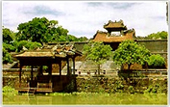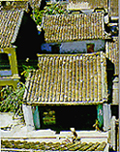|
||||||||
 |
|||
 |
 |
|
|
 |
 |
 |
 |
 |
 |
|
VIET NAM HA LONG BAY
Halong Bay is made up of 1,969 islands of various sizes, 989 of which have been given names. There are two kinds of islands, limestone and schist, which are concentrated in two main zones: the southeast (belonging to Bai Tu Long Bay), and the southwest (belonging to Halong Bay). This densely concentrated zone of stone islands, world famous for its spectacular scenery of grottoes and caves, forms the central zone of Halong Bay, which has been named a UNESCO World Heritage Site. The bay itself has an area of 43,400 ha, consists of 775 islands, and forms a triangle with the island of Dau Go (Driftwood Grotto) to the west, the lake of Ba Ham (Three Shelter Lake) to the south, and the island of Cong Tay to the east. Viewed from above, Halong Bay resembles a geographic work of art. While exploring the bay, you feel lost in a legendary world of stone islands. There is Man's Head Island, which resembles a man standing and looking towards the mainland. Dragon Island looks like a dragon hovering above the turquoise water. La Vong Island resembles an old man fishing. There are also the islands of the Sail, the Pair of Roosters, and the Incense Burner, which all astonishingly resemble their namesakes. The forms of the islands change depending on the angle of the light and from where the islands are viewed. At the core of the islands, there are wonderful caves and grottoes, such as Thien Cung (Heavenly Residence Grotto), Dau Go (Driftwood Grotto), Sung Sot (Surprise Grotto), and Tam Cung (Three Palace Grotto). Halong Bay has many links to the history of Vietnam. For example, there are such famous geographical sites as Van Don (site of an ancient commercial port), Poem Mountain (with engravings of many poems about emperors and other famous historical figures), and Bach Dang River (the location of two fierce naval battles fought against foreign aggressors). It has been proven by scientists that Halong was one of the first cradles of human existence in the area at such archeological sites as Dong Mang, Xich Tho, Soi Nhu, and Thoi Gieng. It is also a region of highly-concentrated biological diversity with many ecosystems of salt water-flooded forests, coral reefs, and tropical forests featuring thousands of species of animal and plant life. With all this in mind, the 18th meeting of the Committee of the World Heritages of UNESCO (in Thailand on December 17th, 1994), officially recognized Halong Bay as a natural heritage site of worldwide importance. PHONG NHA KE BANG NATIONAL PARK
The over 200,000 ha of parkland includes beautiful limestone formations, grottoes and caves, and boasts lush forestland covering 95 percent of the park area. The area is considered a paradise for researchers and explorers of grottoes and caves, and Vietnamese and British scientists have so far surveyed 20 with a total length of 70km. Of them, 17 are in the Phong Nha area and three in the Ke Bang area. The Phong Nha cave itself which lends its name to the whole system is probably the most beautiful of all, containing many fascinating rock formations, enchanting visitors with evocative names such as Lion, Fairy Caves, Royal Court and Buddha. Besides the grotto and cave systems, Phong Nha has the longest underground rivers, the largest caverns and passageways, the widest and prettiest sand banks, and the most astonishing rock formations in the world. According to initial statistics, the primitive tropical forest in Phong Nha-Ke Bang houses 140 families, 427 branches, and 751 species of high-rated plants, of which 36 species are endangered and listed in the Viet Nam Red Book. The forest is also home to 32 sets, 98 families, 256 races and 381 species of four land backboned animals. Sixty-six animal species are listed in the Viet Nam Red Book and 23 other species in the World Red Book. In general, Phong Nha-Ke Bang's animals are more diverse than in other natural reserves and national parks.Phong Nha-Ke Bang also boasts dozens of mountain peaks of over 1,000 metres still unexplored by men and seen as ideal sites for activities like climbing and exploration. Worthy of note are Peak Co Rilata with the height of 1,128 m and Peak Co Preu, 1,213 m. Lying between these peaks are valleys which promise tourists exciting eco-tours. In addition to the diversity in the ecosystem, Phong Nha-Ke Bang is home to archeological and historical relics, such as an ancient hieroglyphic script of the Cham ethnic minority, King Ham Nghi's base built for the resistance war against French colonialists in the late 19th century, and the Xuan Son ferry station, Ho Chi Minh Trail and Road 20 used during the US resistance war. Central Quang Binh province has poured heavy investment into upgrading the Phong Nha-Ke Bang visitor site to turn it into the country's major tourist destination HUE ANCIENT CAPITAL CITY On the Northern bank of Perfume River has relics consisting of palaces, which
were constructed as arc defensive ramparts with 11km length. This valuable construction
includes more than 100 arichectural works which were extremely reflected the
life of Emperors and mandarins under Nguyen' reign. Situated in the middle of
hills on the Southern bank of Perfume River are very beautiful tombs of Nguyen
Kings. Among these tombs are the four famous ones with the name and the arrangements
of the tomb reflected each Emperor's points of view, personality, and tastes.
This is majestic Gia Long tomb, imposing Minh Mang tomb, poetic Tu Duc tomb
and magnificent Khai Dinh tomb. MY SON SANCTUARY
According to records on the stone stele, the prime foundation of the ancient My Son architectural complex was a wooden temple to worship the Siva Bhadresvera genie. In the late 16th century, a big fire destroyed the temple. Step by step, historical mysteries were unveiled by scientists. Through stone stele and royal dynasties, they proved My Son to be the most important Holy Land of the Cham people from the late 4th to the 15th centuries. For many centuries, the Cham built Lip, a mutually linked architectural complex, with baked bricks and sandstone. The main temple worships the Linga-Yoni, who represents the capability of invention. Beside the main tower (Kalan) are several sub-towers worshipping Genies or deceased kings. Although time and the wars have destroyed some towers, the remaining sculptural and architectural remnants still reflect the style and history of the art of the Cham people. Their masterpieces mark a glorious time for the architecture and culture of the Cham, as well as of Southeast Asia. According to many researchers of the ancient Cham towers, the architectural art of the Cham towers at My Son Sanctuary is the convergence of different styles, including the continuity of the ancient style in the 7th-8th centuries, the Hoa Lai style of the 8th-9th centuries, the Dong Duong style from the mid-9th century, the My Son and My Son-Binh Dinh styles, etc. Among the remnants of many architectural sites excavated in 1898, a 24 metres high tower was found in the Thap Chua area and coded an I by archaeologists and researchers on My Son. This tower is a masterpiece of ancient Cham architecture. It has two doors, one in the east and the other in the west. The tower body is high and delicate with a system of paved pillars; six sub-towers surround the tower. This two storey tower looks like a lotus flower. The top of the upper layer is made of sandstone and carved with elephant and I ion designs. In the lower layer, the walls are carved with fairies and water evils and men riding elephants. Unfortunately, the tower was destroyed by US bombs in 1969. After the My Son ancient tower complex was discovered, many of its artifacts, especially statues of female dancers and genies worshipped by the Cham people, worship animals and artifacts of the daily communal activities, were collected and displayed at the Cham Architecture Museum in Danang city. Although there are not many remnants left, those that remain display the typical sculptural works of cultural value of the Cham nationality. Furthermore, they are vivid proof, confirming the history of a nationality living within the Vietnamese community boasting of a rich cultural tradition.
HOI AN ANCIENT TOWN
The ancient town of Hoi An, 30 km south of Danang, lies on the banks
of the Thu Bon River. Occupied by early western traders, Hoi An was one of the
major trading centers of Southeast Asia in the 16th century.
[top] |
||||||||||||
 |
 |
|
• ASEAN • Brunei Darussalam • Cambodia • Indonesia • Laos • Malaysia • Myanmar • Philippines • Singapore • Thailand • Viet Nam |

 |
 |
 |






